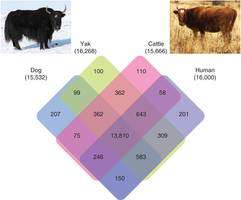July 3, 2012 report
Researchers uncover Yak genes responsible for their altitude tolerance

(Phys.org) -- For some four thousand years, people in Tibet have relied on Yaks to help them survive in the high altitudes in which they live. The Yaks have proven over time that they are far better at dealing with high mountain living than are cows, which are more prevalent in other societies around the world. Scientists have known for years that cows and Yaks are closely related, and that the two were once the same species, having diverged just shy of five million years ago, which is roughly the same time span that humans and chimps went their separate ways. Now, new research by an international team of biologists and geneticists has taken apart the Yak genome and found, as they describe in their paper published in Nature Genetics, the genes that are responsible for allowing the Yak to thrive at such high altitudes.
The Yak (Bos grunniens for the domesticated variety) is a long haired bovine that lives in the Himalayan part of Asia and has been used by people in a variety of ways over the long history the two have shared, e.g. for transport, farming, food and shelter. Up until now however, the DNA of the animal had not been thoroughly studied.
In this new research, the team has found that the Yak possesses several genes that make it particularly suited for high altitude living. Three of them help to regulate its response to low levels of oxygen in the air, which can result in hypoxia, a condition that causes distress in other animals, such as difficulty breathing, panic, nausea, dizziness and of course passing out altogether and edema, which is where fluid collects in the tissues. The team also found five unique genes that control the way energy is obtained from the food the Yak eat, optimizing for the scarce amount available, allowing them to survive on a diet that would not support other animals of its size.
The genetic findings by the team are expected to lead to advances in research in other areas, such as ways to help people better tolerate the extreme conditions present at high altitudes and perhaps better ways to treat those that succumb to its effects.
More information: The yak genome and adaptation to life at high altitude, Nature Genetics (2012) doi:10.1038/ng.2343
Abstract
Domestic yaks (Bos grunniens) provide meat and other necessities for Tibetans living at high altitude on the Qinghai-Tibetan Plateau and in adjacent regions. Comparison between yak and the closely related low-altitude cattle (Bos taurus) is informative in studying animal adaptation to high altitude. Here, we present the draft genome sequence…
Journal information: Nature Genetics
© 2012 Phys.Org















